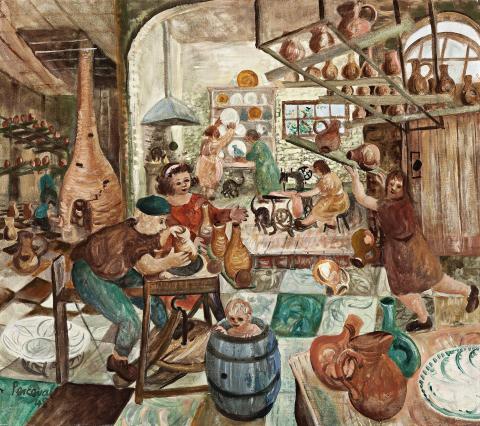THE POTTERY, 1948
JOHN PERCEVAL
oil, resin and tempera on canvas
81.0 x 91.5 cm
signed and dated lower left: Perceval / 48
inscribed verso: MRS WANN / BENALLA / VICTORIA
Melbourne Book Club Gallery, Melbourne
Mrs Wann, Benalla, Victoria
Christie’s, Melbourne, 13 March 1975, lot 468
Private collection, Melbourne
John Perceval (seventeen paintings, thirty-two drawings), Melbourne Book Club Gallery, Melbourne, 1948, cat. 21, (catalogue introduction by Franz Phillip)
Allan, T., John Perceval, Melbourne University Press, Victoria, 1992, p. 151 (as ‘Arthur Boyd Pottery Shop’)
The Potter at his Wheel, mixed media, 79.0 x 74.0 cm, private collection, illus. in Plant, M., John Perceval, Lansdowne Australian Art Library,
Melbourne, 1971, p. 39
When the eighteen year-old John Perceval met Arthur Boyd in 1941, he not only found a steadfast friend, he also found a family. Coming from a childhood marked by divorce, isolation and the blight of polio, Perceval was now welcomed into the extended Boyd family compound at Murrumbeena, a suburb of Melbourne, where generations lived side by side amidst a tangle of vegetation and run-down houses. When he subsequently married Boyd’s sister Mary and had children of his own, the circle became complete. In 1921, Boyd’s father Merric had started Australia’s first ever studio pottery and in 1944 his son-in-law Hatton Beck borrowed some of his equipment to set up a ceramic studio of his own in an old butcher’s shop in nearby Neerim Road. This was then purchased by Perceval, Boyd and their philosopher friend Peter Hebst for two hundred pounds. Renamed the AMB (Arthur Merric Boyd) Pottery, the immediate aim was the ‘mass manufacture of utilitarian crockery to meet the demand caused by wartime shortages’,1 but the war’s end led to an easing of restrictions and the Pottery started to produce ‘a great number of earthenware pots with underglaze painted decoration. Favourite motifs were fighting cocks, flowers, angels and occasional portrait heads.’2
Not surprisingly, the distinction between family and work was blurred and The Pottery captures all the rambunctious energy of the enterprise. ‘I remember going into the shop and thinking aren’t they pale? Of course it was the clay dust! The pottery inside looked like a bomb had gone off. The floor had clay all over the place and no order in it at all. … it had absolutely no appearance of a shop at all. They never said ‘look you kids, rack off’.’3 Initially, Boyd and Perceval tended to work the wheel while their wives glazed and decorated the pieces ‘(but as) the business grew, they called in more and more friends to help out. These included Neil Douglas, Charles Blackman, Jean Langley, Tim and Betty Burstall, John Howley and John Yule.’4 In The Pottery, 1948 Perceval shows himself at the wheel whilst next to him stands Betty Burstall who wears a distinctive hair band. In the foreground the artist’s son plays in a barrel (The Potter at his Wheel, 1947 also features Perceval and the cherubic Matthew). Pitchers tumble from the rafters, women stack the shelves, the kiln blazes away, and surfaces teem with a profusion of calligraphic designs. It is a scene of glorious chaos.
The Pottery belongs to an important cycle of Perceval’s paintings which display the influence of his close study of works by Rembrandt, Brueghel and Hogarth. Earlier, Albert Tucker had introduced him to an influential book on painterly technique5 and through this, Perceval developed a personalised ‘mixed media technique of resinous colour over tempera with a heightening of white, allowing a calligraphic basic drawing and a rather dry scumbled top effect’,6 an approach which is evident in this work. The Pottery and four associated drawings were exhibited in 1948 in the artist’s first solo exhibition at the Melbourne Book Club Gallery, an event which also featured paintings of biblical stories set within Melbourne locations, alongside bucolic scenes drawn from the artist’s intimate Murrumbeena environment. Many of these are now considered major works from the artist’s oeuvre including French Nuns, The Ark, Xmas Eve, The Bar, The Market and the tender Flight to Egypt, now in the collection of the Art Gallery of Western Australia.
1. Haese, R., Rebels and Precursors: The revolutionary years of Australian Art, Penguin, Melbourne, 1981, p. 217
2. Reid, B., Of Dark and Light: The art of John Perceval, National Gallery of Victoria, Melbourne, 1992 p. 18
3. Joy Collins, unpublished manuscript, cited in: Magin, P., The Murrumbeena Boyds: Just like us; but different, Glen Eira City Council, Melbourne, 2006, p. 11
4. Magin, P., op cit., pp. 15 – 16
5. Doerner, M., The Materials of the Artists and Their Use in Painting with Notes on The Techniques Of The Old Masters, Rupert Hart-Davies, London, 1921
6. Plant, M., John Perceval, Landsdowne Press, Melbourne, 1971, p. 26
ANDREW GAYNOR
